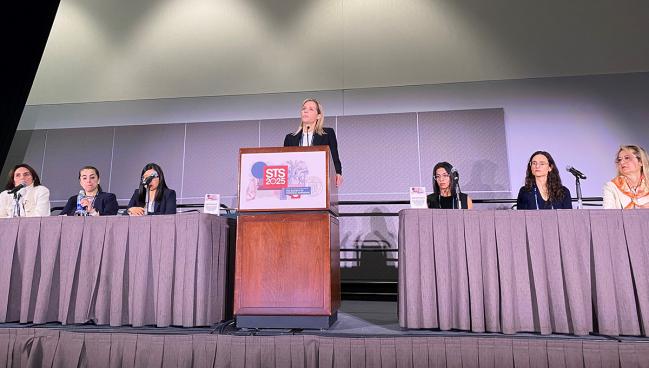STS Experts Tackle Need For Women-Only Trials in Surgery
Greater inclusion of women in surgical trials and reporting of sex-based treatment effects are warranted, they say.

LOS ANGELES, CA—With research showing that women present later and differently with cardiovascular disease—and that they pose unique challenges in the operating room—some experts are calling for more exclusive studies in this population.
At a minimum, they say, there is a need for greater representation in clinical trials.
“Both the pathophysiology of the diseases that we see, as well as the presentation, as well as the treatment and the outcomes are different for men and women,” Maral Ouzounian, MD, PhD (Toronto General Hospital, Canada), told TCTMD. “Apart from just highlighting these differences, we really need to start digging a little bit more into the mechanisms of why these differences are occurring, and then how to mitigate the differences in outcomes that we are seeing.”
Ouzounian, who co-chaired a session on cardiac surgery in women last weekend at the 2025 Society of Thoracic Surgeons (STS) annual meeting, said women are underrepresented as both patients and leaders in cardiovascular disease trials, and “without sort of thoughtful and deliberate attention, [that] will just remain status quo.”
We really need to start digging a little bit more into the mechanisms of why these differences are occurring, and then how to mitigate the differences in outcomes that we are seeing. Maral Ouzounian
“There is no magic involved in addressing the underrepresentation of women in cardiac surgery trials,” said Sigrid Sandner, MD (Medical University of Vienna, Austria). “We need to change what we do, and it demands, I think, a commitment from all of us.”
Few Female Patients, Leaders
In her presentation during the session, Sandner pointed to data showing the percentage of women in cardiac surgery trials dropping from 30% to roughly 20% between 2000 and 2020, with North American trials enrolling slightly more women than European studies; CABG trials enrolled the fewest women across the board compared with other surgeries.
“Such low percentages are very likely inadequate to provide meaningful estimates of the treatment effect,” Sandner argued. “What we need is actually an overrepresentation of women to generate meaningful treatment estimates.”
I think that having trials dedicated to women can be very effective—difficult, but very effective. Sigrid Sandner
When it comes to leadership, there also are data indicating “a paucity of women in academic cardiac surgery,” said Sandner. One study published in the Annals of Thoracic Surgery in 2023 showed of the 58 randomized trials in cardiac surgery published between 2000 and 2022, only eight were led by women, and almost 30% had no female authors.
“Only 1% of the authors were women cardiac surgeons,” Sandner said. “The reason for that is that the majority of women authors in cardiac surgery trials were actually not cardiac surgeons. They’re biostatisticians [and] methodologists from nonsurgical specialties.”
Another study showed that not a single trial in the field funded by the US National Institutes of Health had a female national principal investigator between 2014 and 2019.
This lack of diversity in clinical trial leadership has an impact on the enrollment of women in cardiac surgery trials, argued Sandner. And there are other barriers to enrolling women, she said, such as the typical hurdles of “caregiving responsibilities or perception about elevated risk.” However, “one of the reasons may also be that trials to date have not been designed specifically for women.”
The ongoing ROMA:Women trial—the first in cardiac surgery to enroll only women—has caused a buzz among those eager to know the optimal grafting strategy for women undergoing CABG.
“Its inclusion criteria actually reflect the particular characteristics of the patient population that it targets,” Sandner pointed out. “For example, ROMA:Women takes into consideration that women present for CABG at a more advanced age than men do, and there is no age cutoff for inclusion into the trial. And ROMA:Women also has a very high proportion of women in trial leadership.”
We as surgeons have a lot of power in society and should also be advocating as hard as we are for doing hard things in the operating room for doing the right things upstream. Gregory Hirsch
Some had challenged the notion of an all-women trial in cardiac surgery as being too difficult to recruit, but Sandner said current enrollment for ROMA:Women is already “threefold” ahead of what was expected and is likely to finish enrolling this year. “What this tells us is it is doable,” said Sandner. She even suggested that women-only trials may be more efficient at enrollment than trials led disproportionately by men.
If a sex-specific trial isn’t possible, then women should represent “at least 50% of the enrolled sample to allow a meaningful estimation of the treatment effect in women,” said Sandner.
More Female-Only Trials?
During the panel discussion, session co-chair Gry Dahle, MD, PhD (Oslo University Hospital, Norway), said the lack of diversity in clinical trials leads to treatment recommendations that don’t benefit everybody. “What I think is very scary is that if we have less women in the trials and the guidelines are built on the trials, are the guidelines made from only men?”
Sandner said this is a reasonable concern. “If you have 80% male participation, the tremendous effect that you see is going to reflect the results that you see in men and not women,” she said. “This is at best not good, and at worst potentially harmful to the treatment of women.”
Ouzounian asked the panel if they thought the answer was to conduct more trials dedicated to women.
We only have so much money. We can only spend it on so many trials, right? Justin Schaffer
Panelist Dawn Hui, MD (UT Health San Antonio, TX), said it depends on the demands of the trial. For example, many women cannot take the time to come back to the hospital for frequent tests or imaging scans that a trial might require. For Sandner, though, they are needed. “I think that having trials dedicated to women can be very effective—difficult, but very effective,” she said.
Brittany A. Zwischenberger, MD (Duke University, Durham, NC), another panelist, agreed, adding that her experience as a site principal investigator for ROMA:Women has opened her eyes to how trial inclusion criteria should change to accommodate women.
“All of us have presented that women are sicker when they come for heart surgery,” she said. “So, we have to start there, and a dedicated female trial makes everybody start with a sicker patient population to do these randomizations.”
An audience member asked whether this means separate research for men and women, doubling efforts, with different data and different guidelines. If the guidelines are to be evidence-based, cardiac surgery needs more data on treatment effects in women, Ourania Preventza, MD (University of Virginia, Charlottesville), said.
“What studies at least need to do is report sex-specific treatment effects irrespective of the proportion of women enrolled,” Sandner added. In coronary surgery, for example, both multiple arterial grafting (MAG) and off-pump surgery are suspected to be more beneficial in women than in men, but the large ART trial that studied MAG didn’t report a treatment effect by sex, she said.
“I’m not saying for every pathology you need to do a trial in women,” she argued. “I think the very minimum that we need to do is report a treatment effect by sex, understanding that any subgroup analysis, by definition, will always be underpowered.”
We need to focus more studies on women because I think [operating on women is] just different and can present technical challenges. Joseph F. Sabik II
Audience member Gregory Hirsch, MD (Dalhousie University, Halifax, Canada), noted that women remain undertreated for coronary heart disease long before they reach the operating room. “I just wanted to make the point that we as surgeons have a lot of power in society and should also be advocating as hard as we are for doing hard things in the operating room for doing the right things upstream [of the surgery],” he said.
Hui agreed. “Hopefully there is a ripple effect with the intention of trial inclusion in women that may lift the tide and elevate care, such as secondary prevention, follow-up, things like that,” she said. “And the American Heart Association always needs surgeons present.”
‘A Can of Worms’
Speaking to TCTMD, Justin Schaffer, MD (Baylor Scott & White The Heart Hospital, Plano, TX), who was in the audience for the session, said he had “mixed opinions” on seeing more trials run exclusively in women, because that could open “a can of worms” for people calling for trials that solely enroll patients of certain ethnicities, for example.
“Maybe it’s better that we focus our energies on appropriately recruiting patients so that we have a good distribution of women and people of various backgrounds and social determinants of health in our studies,” Schaffer argued. “We only have so much money. We can only spend it on so many trials, right?”
Incoming STS President Joseph F. Sabik III, MD (University Hospitals Cleveland Medical Center, OH), told TCTMD that there is value in select women-only studies. “We need to focus more studies on women because I think [operating on women is] just different and can present technical challenges.” But, he said, these differences are not present for every type of cardiac surgery, like, for example, mitral valve repair, “where it’s really no different.”
The more frequent the disease is in women, the higher the representation of women must be in the trials. Mario Gaudino
Mario Gaudino, MD, PhD (Weill Cornell Medicine, New York, NY), who is leading ROMA:Women, agreed that it depends on the research query. “There are some interventions or areas where we know sex-based differences are very important, and it is extremely likely that what we do observe in one sex does not apply to the other,” he told TCTMD.
ROMA:Women is studying a “critical sex-specific difference,” Gaudino stressed. Another study might be warranted to look at differences in the cause and impact of anemia in cardiac surgery. “For those situations, I would argue that trials dedicated to women are needed. Because if you accept the idea that there are very important differences between sexes for a specific topic, then it doesn’t make sense to pool the two patient populations because the overall estimate will be just a mix of two very different results.”
As for how many women should be enrolled compared with men, Gaudino said a 50-50 split “is one option,” but in some cases, it might make more sense for researchers to enroll based upon the prevalence of the disease in question among the sexes. “The more frequent the disease is in women, the higher the representation of women must be in the trials,” he explained, adding that separate inclusion criteria by sex might also be considered.
“The bottom line is that . . . one of [our trial planning] checkboxes should be representation of women,” he said. “Based on the research question, there should be a process of thinking of how many women are needed in this trial because of this specific question and how do we get there. . . . There is no one size fits all, but at least we have to change.”
Yael L. Maxwell is Senior Medical Journalist for TCTMD and Section Editor of TCTMD's Fellows Forum. She served as the inaugural…
Read Full BioSources
Sandner S. Women in cardiac surgery trials: where do we need to be? Presented at: STS 2025. January 24, 2025. Los Angeles, CA.
Disclosures
- Gaudino reports being the PI of ROMA:Women and RECHARGE:Women.
- Ouzounian reports serving as a speaker for Artivion.
- Preventza reports serving as a consultant for Artivion.
- Sabik reports serving on the advisory board and as a speaker for Medtronic.
- Sandner, Dahle, Zwischenberger, Schaffer, and Hui report no relevant conflicts of interest.





Comments